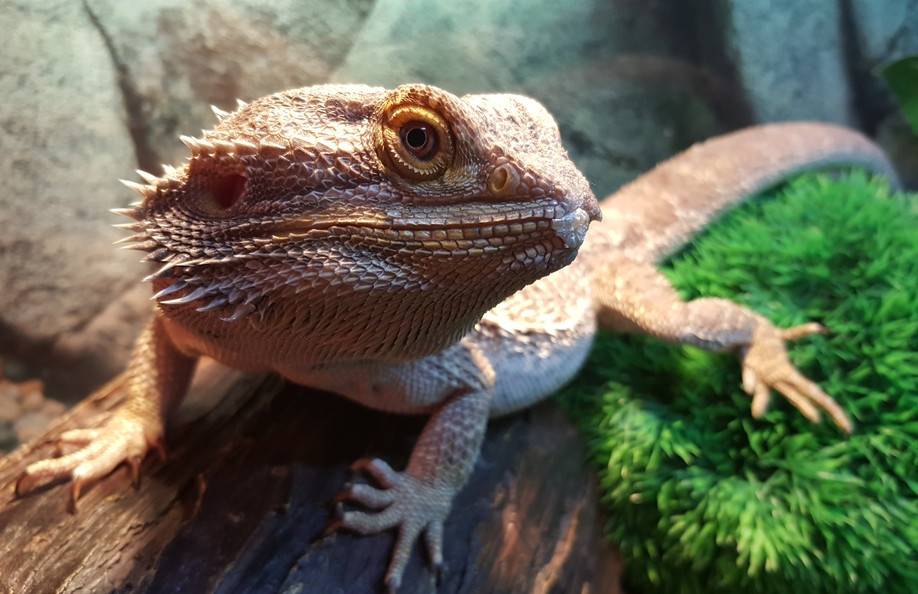This is the illness that every bearded dragon owner fears! There is no cure and sadly it will lead to death at some point. Although it is fatal, with the right treatment and special care, your beardie can still live for a long time.
Yellow fungus is an aggressive flesh-eating fungal infection found mostly in reptiles also known as CANV. Many times the infection will start from within and work itself to the outer parts of the bearded dragon. It can affect the skin as well as the organs. The sad part, by the time symptoms, are noticed on the skin, there is a good chance that the disease has already damaged the inner tissues. Now, before you completely stress out, remember, that there are other skin diseases and infections that could also affect the skin. If Yellow fungus is suspected, you SHOULD find a reptile vet ASAP and have tests done. I do recommend having 2 opinions from different vets to be sure.
A skin scrape will be done to rule out mites, parasites, skin conditions, or any other kinds of bacterial infections. Blood work will also give an accurate prognosis and will also pick up any underlying diseases that your dragon could have.
What are the Causes of Yellow Fungus?
Dirty conditions – Bearded dragons that are exposed to dirty conditions are at risk of infection.
Crowding – When too many dragons are housed and handled together without proper quarantine measures. This is a contagious disease; new bearded dragons should always go through a quarantine phase until they are given a clean bill of health. In many instances, an infected dragon in a pet store, breeding facility, or rescue center can carry the disease and infect many others.
Stress – It will lower the immune system of a bearded dragon drastically and thus make them vulnerable to infections.
Bite wounds – When an infected dragon bites another dragon, the disease could pass on to the other.
Antibiotics – Although it is not a proven fact, many discovered that bearded dragons who are given constant dosages of antibiotics are more prone to develop Yellow Fungus. Antibiotics destroy their natural defense system if used too much, making them vulnerable to infections. As a general rule to keep a bearded dragon healthy, probiotics should always be given when antibiotics are administered.
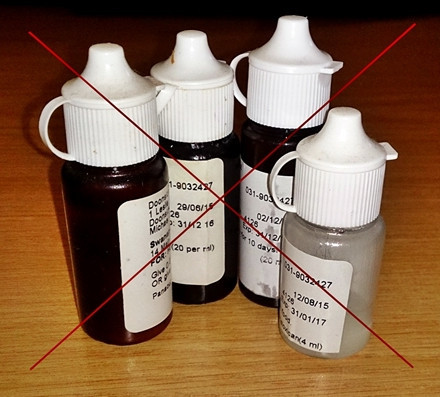
What are the Symptoms of Yellow Fungus?
Listed below are the most common symptoms that can be identified with the illness. Keep in mind that although each one may appear, in many instances, only one symptom will be noticed. Each symptom should be taken seriously, even if there are not any other symptoms as listed below.
- It will show up as a yellow, brown, or greyish patch on the surface of the scales. Usually starts with a small spot that gets bigger. In addition, as time goes by, more spots may appear on other parts of the body. As the disease progresses, the color of the patches will become dark, cracked, or crusty.
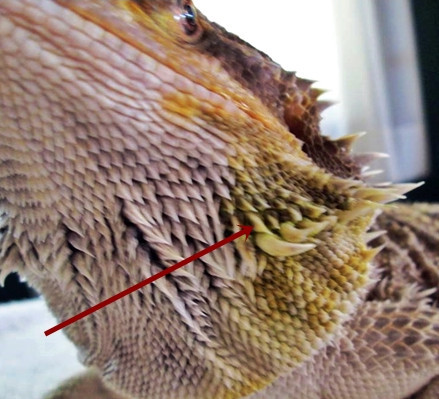
- Irregular shedding that leaves behind dull or discolored scales with a rough appearance. A bearded dragon that is shedding on a constant basis, even though it did not gain weight or grow can also be a reason to worry since it can be the early signs of yellow fungus.
- Weight loss, poor appetite, sunken eyes, and restless behavior that goes along with one or more of the symptoms mentioned.
- Wounds that have discolored scales around them are swollen badly, or discrete a puss.
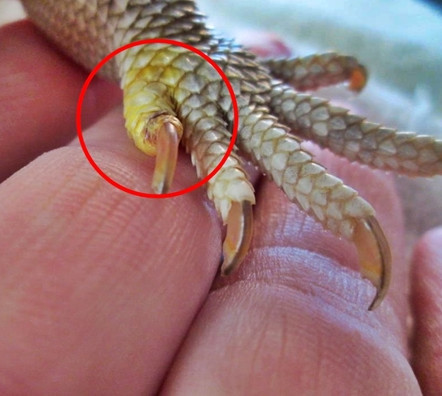
- Wounds that do not heal in a reasonable time frame.
- Body parts that turn black and break/fall off.
What is the Treatment for Yellow Fungus?
Unfortunately, as mentioned above, there is no cure for the disease. However, there are various treatments available to keep your dragon in a “healthy state” for as long as possible. Let’s have a look at a few of them:
- Anti-fungal drugs – Oral combination treatments of itraconazole and terbinafine and so forth.
- Homeopathic medicines combined with conventional treatments. Example: Using Colloidal Silver water and Nolvasan. (Recommended by many)
- Skin treatment with povidone-iodine twice daily.
REMEMBER! You absolutely cannot apply the treatments mentioned above without consulting with your reptile vet first. Dosages will need to be worked out according to weight and the stage of the illness!
What Else Can I Do?
Start your Dragon on Probiotics! This will strengthen the immune system and help them fight the disease. Other supplements like bee pollen and royal jelly that are added to the food will build the immune system as well since it is high potency.
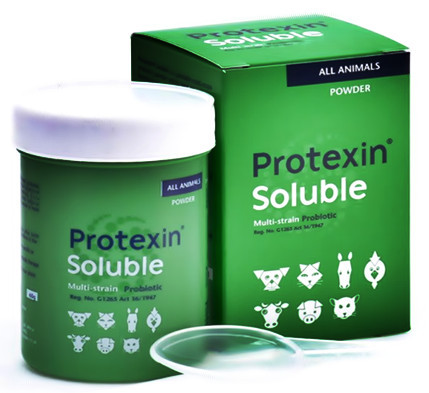
A dragon that is not eating? Mix supplements mentioned above (bee pollen and royal jelly), into organic baby food. Feed it to your dragon by dropping a little bit at a time on his/her snout. Most dragons will lick it off.
Give your dragon as much direct sunlight as possible. Natural UVB will also boost the immune system.
The correct diet! Your dragon is fighting a serious illness and his/her body needs all the nutrition possible to help combat deterioration. Cut all the “occasional foods” and only give staples unless advised otherwise by a veterinarian. (See diet food chart).
Avoid stress. Constant stress will significantly lower the immune system of a dragon. Keep your dragon as calm as possible and eliminate factors that will cause stress like hard noise, other animals in the same room, and so forth.
Change the habitat. Only use newspaper or paper towels for the substrate and change it every day. NO cage furniture that is made of wood or anything organic that will allow the fungus to grow. Plastic rock and wood logs are fine. The cage with all accessories should also be cleaned with a disinfectant like F10 once/twice a week. This will kill any kind of bacteria that could compromise the already weakened immune system of your beardie. Remember to rinse items well after cleaning; no disinfectant should be left behind. A soft baby blanket inside the cage will do wonders. Beardies love soft, warm things, it calms them down.
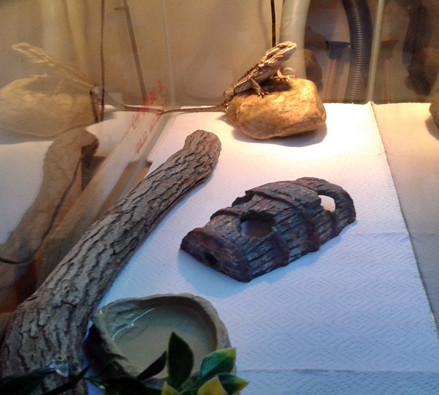
Have regular vet checkups
to make sure that your dragon is thriving and coping with the disease.
Give your bearded dragon tons of love and attention! A sick pet will feel stressed and nothing better than the comfort of his/her owner to make them feel better.
Is Yellow Fungus Contagious?
Yes, it is highly contagious for reptiles and can easily spread from one to another. Any dragons that were in contact with an infected one should also be quarantined and watched closely for any signs of infection. A vet visit is a must; tests will catch it in the early phase before it attacks the internal tissue or rules out the disease altogether and gives you peace of mind.
A bearded dragon with YF should be kept far away from other reptiles and you should wash your hands before and after handling your sick pet!
What About Humans, Can We Get YF from an Infected Dragon?
Reports of healthy people contracting YF from a reptile are almost nonexistent due to the fact that our immune systems are much stronger than reptiles. However, those with poor immune systems should be careful when dealing with reptiles suffering from YF. Example: People with HIV/AIDS, those who had organ transplants, or those receiving cancer treatment. Best to have a talk with your MD about YF if you have one of these illnesses.
How Long Will My Bearded Dragon Live?
The majority of infected dragons will die within 12 to 18 months, depending on the severity of the disease. However, it is reported that many lived up to 5 years fighting it successfully as healthy dragons.
It is impossible to make an accurate prognosis because various factors will determine how long he/she will stay healthy. This includes the types of treatments, diet, general care, attention, and so forth.
How Will I Know When It Is Time to Put My Dragon to Sleep?
When the Yellow fungus enters the aggressive stage, it will infect every part of the body. The dragon can lose limbs, eyelids, lips, and parts of his/her face. In addition, it will lead to poor appetite or a dragon not eating at all, severe weight loss, and constant Lethargic behavior.
Considering the extreme pain they must feel as the disease progresses in full, euthanasia should definitely be a consideration! Yellow Fungus does not kill quickly, the bearded dragon will suffer to death, and in all honestly, no one, should allow it to go that far, it is cruel!
As long as the bearded dragon is still active, alert, eats well, does well with the treatments, grows, and has a generally healthy appearance; euthanasia should not be an option. However, when signs of severe discomfort like those mentioned above occur and deterioration starts to take place, it would be time to make a vet appointment to arrange to put your pet to sleep before it gets too bad for him/her.
What Can I Do to Prevent My Bearded Dragon from Getting Yellow Fungus?
- Proper sanitation and general hygiene are the major risk reducers. Keep them and the cage clean by bathing your beardie at least 3 – 4 times a week and cleaning the cage once/twice a week.
- Remove waste like poop and old food as soon as possible.
- Change the substrate frequently. Do not use substrates like bark/sand, it is common for any kind of bacteria and parasite to grow and thrive in these.
- Use proper disinfectants and cleaners like F10.
- Wash your hands when you handle other reptiles!
- Do not allow other reptiles near your healthy one; you never know what kind of diseases the other might have. If you get a new bearded dragon or a reptile, it should have a quarantine period of 2 weeks to rule out any underlying illnesses, or, until your vet has given it a clean bill of health (Recommended)
- Invest in probiotics! This will strengthen the immune system. Any kind of antibiotic or parasite treatment will not only kill the infection/parasite but also damage the immune system. If your bearded dragon had antibiotics, probiotics are a must!
Keep your dragon healthy with the correct setup, diet, and general care. Feel free to browse this site, if you are unsure about the correct bearded dragon care.

Pictures of Jesse provided by Becky Cordy
